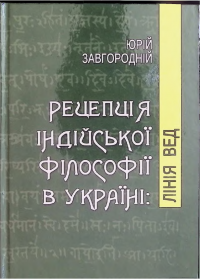Perception of the Indian Philosophy in Ukraine. The Line of the Vedas (1840 -1930-s): Kyiv, Instytut filosofiyi im. H.S. Skovorody NAN Ukrayiny [Skovoroda Institute of Philosophy, National Academy of Sciences of Ukraine], 2013, 412 p.
Keywords:
Ukrainian historiography, Buddhism, VedantaSynopsis
The monograph deals with the analysis of the perception of Indian religious and philosophical thought by Ukrainian intellectuals within a period of almost one hundred years: starting from the appearance of the first publication in 1844 till the 1930s, when the Indology vector of historico-philosophical studies in Ukraine ceased to exist, having fallen victim to the new political situation. The texts of Ukrainian authors are considered in the synchronic and diachronic Indological historico-philosophical context, involving the works by European, Russian, Indian as well as American and Japanese scholars from the 19th to the beginning of the 21st century. Special attention is paid in the monograph to the Indian religious and philosophical primary sources. Among methodological strategies employed in the monograph are philosophically significant ideas, the theory of structural polymorphism, and philosophical traditionalism.
CONTENTS
Foreword
Introduction. The choice of the direction and methodology of the study
Chapter I. Perception of the Indian philosophy in Ukraine: Bibliographical aspect
Chapter II. Review of the literature on the topic
Chapter III. Emergence of the Indian philosophy: Search for the starting point (methodological remarks)
Chapter IV. Perception of the Rigveda hymn X. 129: Peculiarities of translation and interpretation (D. Ovsianyko-Kulykovskyi as well as O. Kozlov, Lesia Ukrainka, P. Ritter, M. Kalynovych and V. Schayan, 1884-the 1930-s)
Chapter V. Peculiarities of resorting to the Upanishads: From mentions in general essays to separate articles and translations
5.1. Initial period of the study of the Upanishads in Ukraine: O. Novytsky, S. Gogotsky, O. Kozlov, V. Lesevych, O. Gilyarov, I. Franko (1840-1910)
5.2. Specifics of P. Ritter’s understanding of the Upanishads
5.2.1. P. Ritter’s characterization of the Upanishads in the articles of the «Granat Encyclopedic Dictionary» (1911-1935)
5.2.2. The Katha Upanishad in P. Ritter’s translation (1933): the Katha Upanishad among the Upanishads, motivation for the selection of the text and peculiarities of translation
5.3. The Upanishads in the context of the ancient Indian religious and philosophical literature: Exemplification through certain research articles
5.3.1. The theme of the Upanishads in article by S. Schayer «On the Genesis of Monism of the Upanishads from the Magical World Outlook of the “Atharvaveda” and the Brahmanas» (1924) as well as in his review (1924) of the translation of eight Upanishads by S. Michalski (1924)
5.3.2. «The Theory of the Upanishads» in the panoramic exposition of the Indian culture in article «The Con-Centers of the Indian World Outlook» by M. Kalynovych (1928)
Chapter VI. Studies of the Vedanta (1844-1935)
6.1. The doctrine of the Vedanta according to Badarayana’s «Brahma-Sutra»
6.1.1. «An Outline of Indian Philosophy» by O. Novytsky (1844)
6.1.2. «The Gradual Development of the Ancient Philosophical Teachings in Relation to the Development of the Pagan Beliefs. Part I. Religion and Philosophy of the Far East» by O. Novytsky (1860)
6.1.3. Articles by S. Gogotsky in «The Philosophical Lexicon» (1857-1873)
6.2. The Vedanta in dynamics: From Badarayana’s «Brahma-Sutras» to the Neo-Vedanta
6.2.1. «Essays in the History of Philosophy. The Concept of Philosophy and History
of Philosophy. Oriental Philosophy» by O. Kozlov (1887)
6.2.2. P. Ritter’s articles in the «Granat Encyclopedic Dictionary» (1911-1935)
6.2.3. S. Schayer’s review (1925) of the translation of the “Atmabodha” by S. Michalskyi (1923)
Conclusion
Bibliography
Index
Contents
Summary
Downloads




